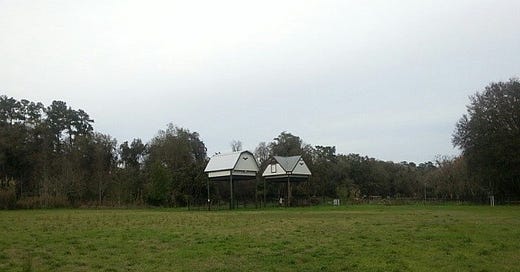A Zoo of One’s Own
A personal essay about the artificial environments we create with varying degrees of agency
Anyone who has made the journey from suburb to the city knows that space is a luxury. New Yorkers, especially, are used to living in such close quarters with each other that a level of dissociation is necessary for the survival of a species.
It’s the start of another feral summer in New York, and I am at the Central Park Zoo navigating an artificial landscape designed not for animals, it seems, but for strollers, which wind their way up the elevated slopes of the zoo with surprisingly no traffic jams.
The people driving them are cruising, perhaps for the first time in a loooong time. They are nannies and families on vacation who come to the zoo to turn their brain off for a bit, knowing their child is not in danger and photos are encouraged—opportunities staged actually, like mini sets furnished with fake logs to sit on that make you think, without a question, “I should take a photo in front of these facts about the foraging habits of bears.” I am making memories alongside them.
The quintessential New York zoo experience is produced by the Wildlife Conservation Society (WCS), the non-governmental organization that owns and operates five such zoos across New York City. The WCS was founded in 1895 as the New York Zoological Society, which achieved their mission of establishing a “free zoological park containing collections of North American and exotic animals, for the benefit and enjoyment of the general public, the zoologist, the sportsman and every lover of nature,” with the opening of the Bronx Zoo in 1899. In 1902, they established enough legitimacy that the City of New York gave them the New York Aquarium. And in the late 1980s, via contract with the Department of Parks and Recreation, the organization “assumes management of (and redesigns) the New York City zoos.” Central Park came first in '88, followed by Queens Zoo in 1992 and Prospect Park Zoo in 1993.
I’m not sure if the society’s sponsor, Teddy Roosevelt, had a vision of creating a sort of Zoo-opoly in New York, but the creation of the Bronx Zoo can be interpreted as a sort of response (perhaps “I can do it better”) to the original version of the Central Park Zoo, which opened 30 years prior as a simple menagerie (It wasn’t the Central Park Zoo until Robert Moses incorporated it into his plan for Central Park in 1934).1 But by 1993, zoos were criticized as depressing places,2 and the ceremonial handing over of zoo-as-park to a NGO was a major turning point in the architecture of zoos, replacing cages to house animals with naturalistic exhibition design.
The same year the New York Zoological Society acquired their final zoo (for now…Staten Island Zoo holds strong), they rebranded as the Wildlife Conservation Society—positioning themselves far away from any jail-like associations. Much of the exhibition graphics at the Central Park Zoo try really hard to make you not think about New York, and instead think fondly of the WCS’s work in Asia, for example, where they “partner with other organizations to develop new ways to monitor snow leopards.”
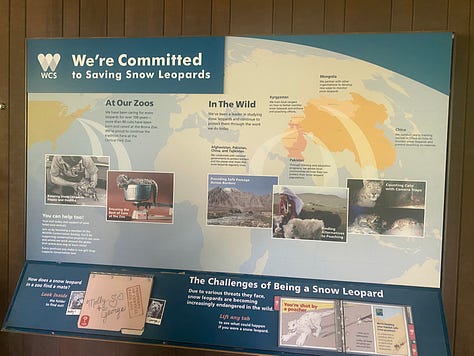

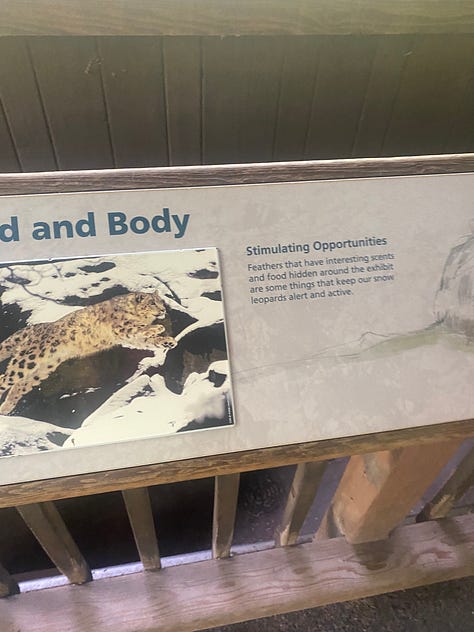
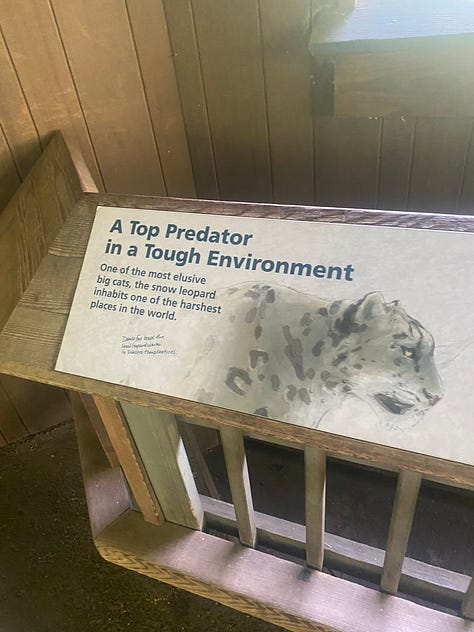

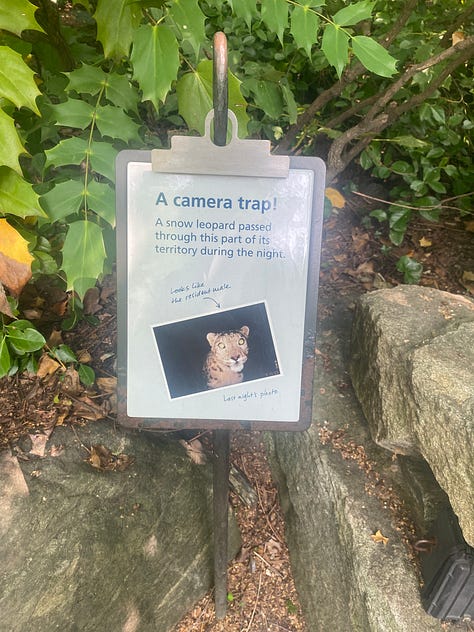
In effect, the actual animal exhibits are designed for surveillance, which only sometimes qualifies as entertainment. So you might as well get your photo now.
Today, Central Park Zoo exhibits about 1,400 animals on roughly seven acres of land, making it one of the smallest accredited zoos in the United States, next to California’s Charles Paddock Zoo weighing in at just 5-acres. The zoo I grew up going to, The Miami Metro Zoo,3 by comparison, is home to 2,000 animals spread across 750 acres on 2,000 acres of land owned by the US Department of Defense (which was originally purchased during World War 2 to serve as a blimp base). If it was good enough to conceal a blimp, a giraffe or elephant could be presented to visitors in landscapes that, while artificial, were ultimately unsuspicious.
You can find plenty of capital-D Discourse about surveillance in cities, of which I’m sure I will contribute very little. Foucault wrote his popular theory of panopticism in the 1970s, way before CCTV and targeted advertising were nuisances largely accepted in public space and personal devices. “Panopticism” is taught in design schools as a matter of ethics, and it is incorporated in architecture education specifically because the Panopticon was a program designed by Jeremy Bentham in the 18th century, originally as a prison, but with the potential to expand into hospitals, schools, and factories if we skeptics ever felt like just giving up handing over the wheel to Big Architecture.
The thing about that essay that many people overlook is Foucault’s suspicion of Bentham’s design being all that original. A true French schoolboy, Foucault brings up a bit of trivia, reminding us of the Royal Menagerie at Versailles—a modification of the landscape that was so significant to King Louis XIV that it was the first project he commissioned. Architect Louis Le Vau’s design for the menagerie (coincidentally the same size as Charles Paddock Zoo) was the first of its kind, “in which the different elements are not, as they traditionally were, distributed in a park,” Foucault noted. “By Bentham’s time, this menagerie had disappeared. But one finds in the program of the Panopticon a similar concern with individualizing observation…”4
The ironic thing about putting animals in overly programmed interiors in the name of conservation is that observation cannot be separated from subjectivity. Such architecture does succeed in “appealing to [our] hearts and minds,” as the WCS claims, but controlling what the heart wants or the mind thinks is still thankfully out of reach for designers.
Unlike other exhibition designs, zoos display living creatures, not artifacts. In this way, there is more in common affectively between zoos and domestic or workplace interiors through the banality and fantasy present in these everyday spaces, which offer tools for users to actively construct meaning through.
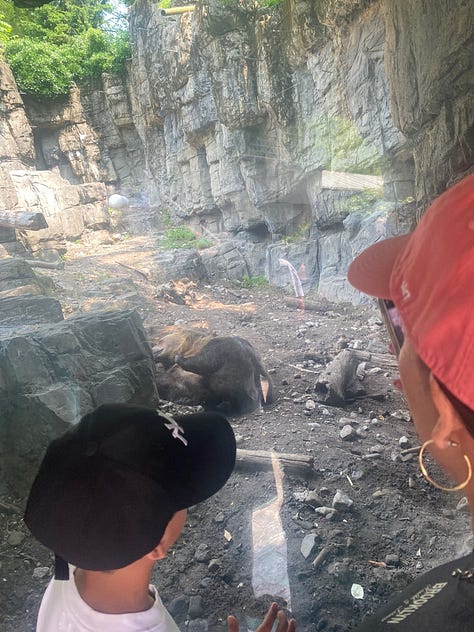
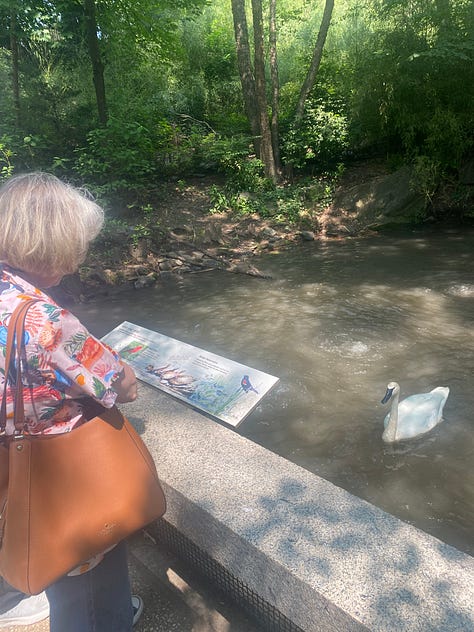
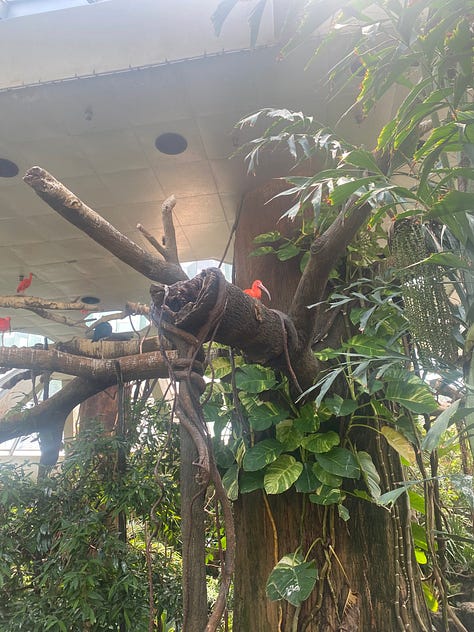
At the Grizzly Bear exhibition entrance, a man declares in Spanish that the bear “esta muerto.” His wife assures him, the bear isn’t dead—only sleeping. This bear, zoinked out on a rock, looks depressed, I think. I’ve been there. This toucan is transfixed by a simulated forest, but someone put blue painter’s tape on the plexiglass out of empathy (?) as if to break the mirage. Fuck. Inside the tropic zone, scarlet ibises perch on a rainforest canopy interrupted by… industrial ceiling tiles? I feel like I’m on drugs, everything is absurd and plain, so funny in the face of confusion.
This whole place is unnatural, designed to represent nature but there are six motor pumps bubbling up water where a solitary swan swims. Instead of appreciating the graceful beauty of the deadpan swan, I am wondering if geese ever flock to the geysers in Yellowstone for a spa day, but it plays out like an episode of Looney Tunes in my mind.
I love being at Central Park during twilight. Watching the bats fly across a field reminds me of living in Gainesville and riding my bike past the bat houses on the college campus, where they would come out in a stream across from Lake Alice. When I was younger, I used to look for new ways to exhaust myself. Now I like to sit very still and just watch. In the zoo’s tropic zone, you can witness the other bats that live in Central Park, the ones which live behind glass. They flutter back and forth beside a desert mural.
I am sitting on a perfect bench carved in relief from the rocks of a fake cave watching them, when a zoologist interrupts my fantasy by ushering a group of children through my private auditorium. He tells them that bats are nocturnal mammals, and technically yes, it is daytime, but we make them think it's nighttime so we can see them when we’re awake. “What happens when we leave?” a kid asks.
We turn the lights on.
I am cynical when I start to think about how depressing it is to play God for bats but I catch myself and remember how we are not immune to similar constructions.
Later that day, I ride the train home, balancing myself on a steel branch, swaying alongside animals of my same species. We try not to look at each other out of respect, like apex predators. In the moving interior of this subway car, each person is their own island. On this island, we build little houses for ourselves starting with the threshold. The rooms materialize with the help of multiple windows, through which we see landscapes of information made more real by private sound and image.
“Imagine we are in Bristol. We are 23 years old, and we just took our eighth bump of ketamine,” my friend prompts me.
So I close my eyes.
We are 600 people deep in a warehouse that has been transformed into a liminal space by towers of speakers and scaffolding of red lights that chase one another up and down the corridor. For the last couple of hours, I thought I was making my way closer to the DJ only to realize I was barely halfway through an ocean of people moving with me nowhere.
I pull myself into my friend and press my ear to his mouth in an attempt to to cut through the sound. He is describing the room he was in ten years ago, watching the same DJ we are here for tonight. I like imagining him younger, less jaded. I hold onto his shirt like a telephone cord, of which I am his private receiver.
“I’ve never done ketamine,” I tell him, but I am on other drugs so I am able to get there—in the Bristol of my mind, in an interior with fuzzy edges. I make out some furniture that I know is not there for him the way it is for me. We fly back and forth ’til 5am. There is a wedding booked for 10am; a white tent is already set up outside in case it rains. We know the rave will end at 6, and we don’t want to be there when the lights turn on.
A woman and a man walk through a plastic cave. “Poor bats,” she says. “They just want to be free.”
Because the zoo existed as a menagerie before, it was never fully designed conceptually from start-to-finish (the exception is the Tisch Children's Zoo within the Central Park Zoo, which opened with a sort of “fantasy playground” design scheme in 1961 and was later redesigned to appear more naturalistic in 1996). Robert Moses brought on the architect Aymar Embury II to design a “picture-book zoo” in 16 days that would be incorporated within Moses’s clean-up of Central Park, funded by the Works Progress Administration (WPA).
Charles Siebert, “Fear of Zoos,” New York Times, February 9, 1993, https://www.nytimes.com/1993/02/09/opinion/fear-of-zoos.html.
Today known as Zoo Miami
Michel Foucault, “Panopticism,” reproduced in Race/Ethnicity: Multidisciplinary Global Contexts 2, no. 1 (2008): 7.


